 Cultural Visit to Coffee Plantation
Cultural Visit to Coffee Plantation
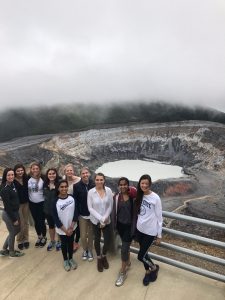 Cultural Visit to Poas Volcano
Cultural Visit to Poas Volcano
Reflection Two
Prompt: Discuss how population structure, dependency ratios, birth and death rates, infant mortality rate, age, sex, race/ethnicity, in-migration, out-migration, and net migration influence health and health services in Costa Rica.
Response:
Below is a graph depicting the population structure of Costa Rica in 2016 taken from the Central Intelligence Agency (CIA) World Factbook (2016).
Costa Rica has a population of approximately 4,800,000. As you can see, the ratio of males to females is tilted slightly in favor of there being more males at all ages except for seniors ages 65+. This population structure is common for most developed countries. The dependency ratio is a measure that shows the number of ‘dependents’ (citizens ages 0-14 and 65+) to the total ‘independent’ population (ages 15-64). The assumption is that dependents do not work and therefore rely on the independents to care for them; dependents do not contribute to economic growth of a country whereas those ages 15-64 are assumed to be of working age and therefore, contribute to the economy. Costa Rica has a dependency ratio of 45.4% (CIA, 2016). For purposes of comparison, the U.S. has a dependency ratio of 51%. Generally, a lower dependency ratio is ideal. The population pyramid below provides evidence that the vast majority of dependents in Costa Rica are those 0-14 which is preferable because in the future, there will continue to be a large enough working population to support the aging population. You can see, however, that there is a bulge of increased population ages 15-30 which may pose a problem when this age group reaches retirement age if fertility levels remain constant or decrease.
The current birth rate in Costa Rica is 15.7 births/1,000 population (global ranking: #122). The current death rate is 4.6 deaths/1,000 population (global ranking: #201). The infant mortality rate is 8.3 deaths/100,000 live births (global ranking: #151) The sex ratio is 1.05 males/females and the median age is 30.9 years. 83.6% of the population is white or mestizo, 6.7% is mulato, 2.4% is indigenous, 1.1% is of black or African descent, and the remaining are categorized as “other”.
Costa Rica is a popular choice for regional immigration because it bolsters job opportunities and impressive social programs due to the government’s investment in social spending; almost 20% of their GDP goes to such programs such as education, universal healthcare, and public sanitation efforts. About 9% of the population is foreign-born, and of those, about ¾ came from Nicaragua. To quantify this, the net migration rate for Costa Rica is 0.8 migrants/1,000 population. (CIA, 2016).
All these demographic factors play a visible role in determining health and health services in Costa Rica. This concludes the background research for response #2. See journal for reflection on Day #2 in Costa Rica and for further analysis of how these factors influence the both individual and population health in Costa Rica.
Visit to Heredia Hospital
Visit to Clinica De Abargandes
Reflection # 3
Prompt: Let’s investigate country-specific data on morbidity and mortality in Costa Rica. What are the main causes of death for different age groups? What are the most prevalent diseases? What are the policies regarding known health risks such as tobacco, drugs, alcohol, sexual behaviors, guns, violence, automobile accidents and so on?
Response:
Below is an infographic taken from www.infogr.am.com created with Centers for Disease Control and Prevention (CDC) data that illustrates the top causes of death in Costa Rica. As you can see, coronary heart disease is most fatal disease with a 16% mortality rate. Next is stroke at 7%, and third is lung disease at 5%. Grouping all the types of cancers together shows that over 20% of deaths in Costa Rica are attributable to cancer. Hypertension and diabetes are prevalent as well, and some deaths are due to non-disease factors such as road injuries (4%) and interpersonal violence (2%) (GBD Compare, 2010). Costa Rica has an adult obesity rate of 24% which is significantly lower than America’s 35.7% adult obesity rate. However, this is still an increase number and contributes to the fact that over 83% of total deaths in Costa Rica can be attributed to preventable, non-communicable diseases. [See pie chart below]. However, chronic disease primarily affects the older population; the probability of dying from NCD in Costa Rica for those ages 30-70 is only 12%. (WHO, 2016).
The two major risk factors for adults are tobacco smoking and alcohol consumption. It is estimated that 24% of males and 8% of females are current tobacco smokers. Measuring alcohol consumption in liters of pure alcohol, men consume 7.5 annually whereas woman consume 3.2 annually. The Ministry of Health does have an operational policy and strategy plan to reduce tobacco use, however, no such plan is in place to reduce alcohol use.
In 2008, Costa Rica joined the WHO Framework Convention on Tobacco Control which places standardized regulations on tobacco. In Costa Rica nearly all public smoking and promotion/advertisement of tobacco is banned. The minimum age to buy tobacco is 18. On tobacco products, 50% of the label must be covered with health warnings (either text or visual). The MOH uses all fines collected from tobacco violations to fund their anti-smoking campaign. They are hopeful to reduce the rate of tobacco use further as it still accounts for nearly 8% of adult deaths and is a hazard to children with 9% reporting tobacco use (The Tobacco Atlas, 2013).
Costa Rica has different regulations surrounding alcohol consumption than the U.S. has. In Costa Rica, the minimum legal drinking age is 16. At 16 it is legal to consume beer and wine and 18 is the legal age for liquor consumption. Public drinking is illegal in Costa Rica. Drinking and driving is not illegal in Costa Rica, however, while you may drink alcohol while driving you may not be intoxicated while driving.
Costa Rica has strict drug laws. The Costa Rican law states that the “cultivation, production, transport, and trafficking of all drugs, including cannabis, are merged in to a single category and are qualified as criminal offenses punishable to 8 to 12 years of imprisonment” (The Costa Rican News, 2014). However, these strict laws fail to prevent drug trade/violence. Costa Rica’s geography, specifically it’s thinly-patrolled borders and waters, paired with a insufficient security force make the country a major transport and storage location for illegal drug trafficking. From 2014 to 2015 there was a 20% rise in homicide rate alone. The government in Costa Rica is focused on eliminating drug trafficking by allocating more spending on enforcement and focusing on counter-narcotics programs. Improvements in the counter-narcotics programs can be attributed to the help provided by the U.S. government in training, equipment, and infrastructure projects.
According to the U.S. embassy, crime is on the rise in Costa Rica. The majority of criminal action is caused by small groups or individuals and while most is non-violent (theft, robbery), violent acts are increasing. In the U.S. Department of State Crime and Safety report for Costa Rica, the crime rating is listed as high. Theft is the main crime affecting travelers, however, the rising homicide rate is a concern for citizens. Sex tourism is also prevalent, and organized crime groups (gangs) are a threat.
On a more positive note, the terrorism rate is low and Costa Rica has a stable democracy with no civil unrest. Police response is available through 911 when needed, however, limited resources often means that delay occurs. The Fuerza Publica is the uniformed policy agency, the Organismno de Investigacion is in charge of investigating all crimes for prosecution, and the Margracion controls all aspects of immigration with assistance from the Ministry of Governorship and Police (U.S. Department of State, 2016).
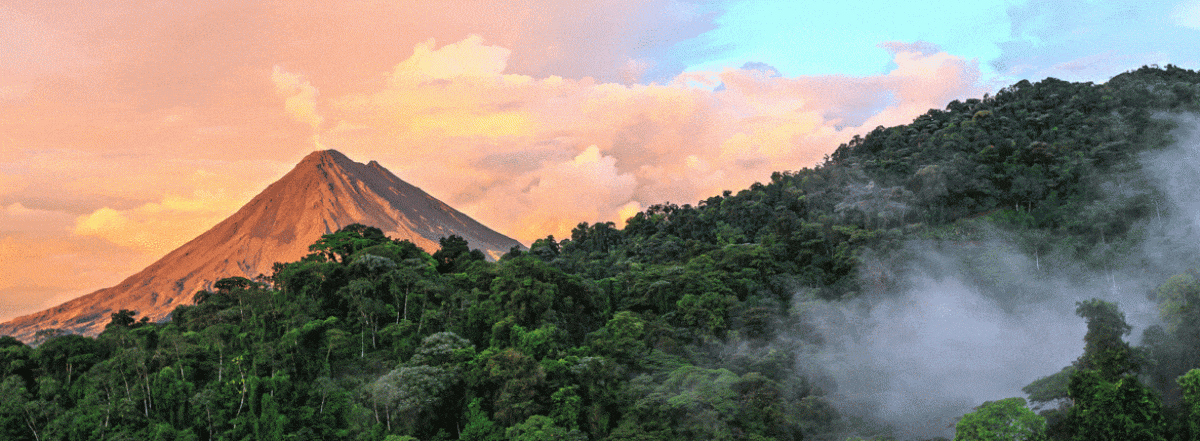

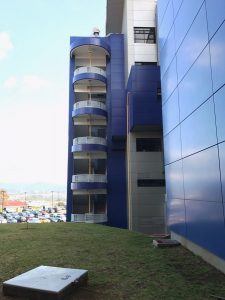
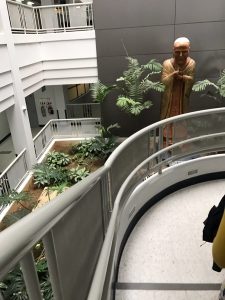


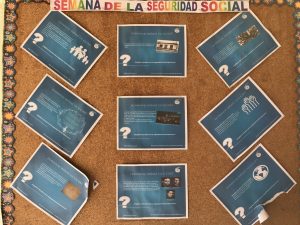

Dear Katie and All,
Hello again, Costa Rica travelers! This was another very informative post. I was especially interested in some of the public health issues, including tobacco and alcohol, among other topics. You might be interested in knowing that President Barron has appointed a task force to explore making Penn State (all campuses) smoke-free. Dean Paula Milone-Nuzzo (College of Nursing) is chairing that group. Hope your travels continue to be productive and intellectually stimulating.
Best Wishes, Nan Crouter (Dean, College of Health and Human Development)
Your photos and posts about the wait times, hospital and clinic sites have been most informative. It was also interesting to hear that facilities may be better off in one area than in another because the politicians try to please certain constituents who have influence. Keep up the good work and safe travels as you wind down your trip. – Dr. Spokus